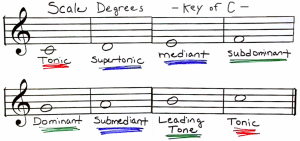SUMMARY
Write your daily summary last, at the end of the day here… Only one to two sentences. DELETE ALL OF MR. LE DUC’s INSTRUCTIONS DETAILED ABOVE AFTER COMPLETING THEM
CLASSROOM
Watch How Melody Works (47 minutes)
- every music system contains/ are based on the same five notes inherently. Those notes are called the pentatonic scale-they’re the five black keys on a piano.
- Notes:
- usually notes are measurably different/ distinct from each other. Not choice is how close together the notes are together.
- how high or low:
- Pitch…
- Intervals…distance between the rungs/notes
- semitones- half
- tones- whole.
- eventually the intervals widened
- the pattern:
- Structure:
- ancient patterns/ archetypes= note families/ Scales/ Nodes
- Related to emotions, times, events, etc
- Sharpened nodes going up flattened going down
- Dissonance= close note collisions: can be used to create tension
- ancient patterns/ archetypes= note families/ Scales/ Nodes
- Blue notes: bend the note down
- Classical/ Diatonic: many instruments tuned to the same node so they can all play together. (which they couldn’t do before)
- the minor scale was made by merging a few of the old nodes (happy)
- The Major Scale: Identical to the ionian (sad)
- Can be switched between easily
- Recycle the same melodic line and put it in a different space.
- establish the pattern and then break it in different ways while using it as the base.
- like a theme in a movie
- Kleizmer songs inspired much of the music for american musicals
LAB
- Hook theory is very simple. I messed around with chords and made a fun tune. Using the chords was especially fun
PRACTICE ROOM
Watch How to practice effectively…for just about anything – Annie Bosler and Don Greene
- I’ve actually seen the practice video a few times before but I always find it encouraging. For practice I started simple with correcting my posture and building up a knowledge of note location to make it second nature just like the video.
OUTSIDE / JOURNAL / IDEAS
Watch Elizabeth Gilbert discuss creativity.
- Separate yourself from your work, and from your success so that they don’t become a burden on you.
- Pull others into your work and success instead. to give it a creative scenius
- Let creativity come from your surroundings rather than yourself.
- “Ass Power”/ work ethic is the main thing you have to be responsible for. Creativity is in many ways out of your hands.
STUDIO
- By Jamie Henke, music.wisc.edu/faculty/jamie-henke/
- As you watch Jamie Henke define and explain melody terms, write them below…
- (hint: if the definition appears on the screen, pause and write it down)
- DELETE ALL OF MR. LE DUC’s INSTRUCTIONS DETAILED ABOVE AFTER COMPLETING THEM
Melody Composition Terms
- Theme – write the definitions next to the term
- Motive
- Period
- Phrase
- Antecedent (Question) Phrase
- Consequent (Answer) Phrase
- Scale Degrees
- Tonic
- Supertonic, Mediant, Submediant
- Dominant, Subdominant, Leading Tone
- Steps
- Leaps
- Conjunct motion
- Disjunct motion
- Repetition
- Contrast
- Variation
Melody Resources


Mr. Le Duc’s Key of C Major Notes and Chords Chart (PDF)
CONTROL ROOM
Learn how to Create Tracks
Explore the Piano Roll, Drawing and Moving Notes
Learn to Edit Notes, Velocity, and More
Learn to Create Your Own Presets
- Write a brief reflection on how this process worked for you.
- DELETE ALL OF MR. LE DUC’s INSTRUCTIONS DETAILED ABOVE AFTER COMPLETING THEM
WHAT I LEARNED and PROBLEMS I SOLVED
Tell your daily story here! Highlight what you learned and enjoyed most. Problem-solving is one of the most important skills you need in life. Employers want to know HOW you get stuff done as much as WHAT you got done. DELETE ALL OF MR. LE DUC’s INSTRUCTIONS DETAILED ABOVE AFTER COMPLETING THEM
WEEKLY ACTIVITY EVALUATION
- Give feedback on the class Content and Process
- Fill in the Weekly Activity Evaluation